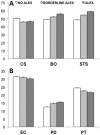Empathy in clinical practice: how individual dispositions, gender, and experience moderate empathic concern, burnout, and emotional distress in physicians
- PMID: 23620760
- PMCID: PMC3631218
- DOI: 10.1371/journal.pone.0061526
Empathy in clinical practice: how individual dispositions, gender, and experience moderate empathic concern, burnout, and emotional distress in physicians
Abstract
To better understand clinical empathy and what factors can undermine its experience and outcome in care-giving settings, a large-scale study was conducted with 7,584 board certified practicing physicians. Online validated instruments assessing different aspects of empathy, distress, burnout, altruistic behavior, emotional awareness, and well-being were used. Compassion satisfaction was strongly associated with empathic concern, perspective taking and altruism, while compassion fatigue (burnout and secondary traumatic stress) was more closely related to personal distress and alexithymia. Gender had a highly selective effect on empathic concern, with women displaying higher values, which led to a wide array of negative and devalued feelings. Years of experience did not influence dispositional measures per se after controlling for the effect of age and gender. Participants who experienced compassion fatigue with little to no compassion satisfaction showed the highest scores on personal distress and alexithymia as well as the strongest indicators of compassion fatigue. Physicians who have difficulty regulating their negative arousal and describing and identifying emotions seem to be more prone to emotional exhaustion, detachment, and a low sense of accomplishment. On the contrary, the ability to engage in self-other awareness and regulate one's emotions and the tendency to help others, seem to contribute to the sense of compassion that comes from assisting patients in clinical practice.
Conflict of interest statement
Figures






References
-
- Halpern J (2012) Clinical empathy in medical care. In: Decety J, editor. Empathy: from Bench to Bedside. Cambridge: MIT Press. 229–244.
-
- Gleichgerrcht E, Decety J (2012) The costs of empathy among health professionals. In: Decety J, editor. Empathy: from Bench to Bedside. Cambridge: MIT Press. 245–2611.
-
- Dyrbye LN, Massie FS, Eacker A, Harper W, Power D, et al. (2010) Relationship between burnout and professional conduct and attitudes among US medical students. JAMA: the journal of the American Medical Association 304: 1173–1180. - PubMed
-
- Batson DC (2009) These things called empathy: eight related but distinct phenomena. In: Decety J, Ickes WJ, editors. The Social Neuroscience of Empathy. Cambridge, MA: The MIT Press.
Publication types
MeSH terms
LinkOut - more resources
Full Text Sources
Other Literature Sources

